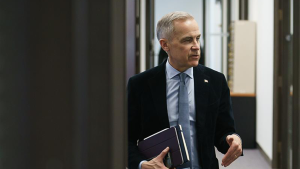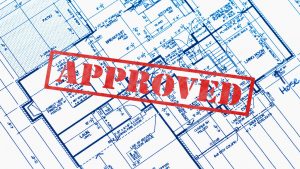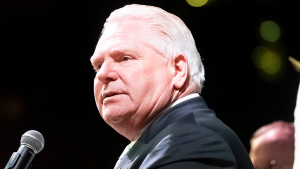Cadillac Fairview and TD Bank Group are celebrating the Toronto-Dominion (TD) Centre’s 50th anniversary with a commemorative exhibition that illustrates how the centre’s unique design has spanned 50 years, helping to shape Toronto’s financial district and transform the city’s skyline.
The exhibition coincides with celebrating Canada’s 150-year anniversary, explained David Hoffman, general manager of the TD Centre, adding the centre was open on July 1, 1967 to coincide with Canada’s centenary.
"It highlights the iconic landmark and its significance, its legacy and its role in the development and growth of the financial district," he said. "It celebrates and commemorates TD Centre’s place in history, in architecture, in Toronto, in the financial district and really TD Centre’s story in Canada."
The installation, located in the foyer of 66 Wellington St. West, features a large-scale digital display and other visual elements exploring the TD Centre’s vision, evolution and ongoing impact on the city and its business community. Outside in the public plaza, a "50" sculpture has been erected. The exhibition will run until the end of August.
With more than 4.3-million square feet of space, the TD Centre is the largest business complex in the country. The development of the centre began as a 50-50 partnership between the Fairview Corporation and TD bank.
"It is a product of one of Canada’s most unique and enduring business relationships between a developer and owner of Cadillac Fairview and the anchor tenant TD bank," explained Hoffman.
"The development of this tower, it changed Toronto’s skyline and it ushered in a new direction for the city. It introduced a modern workplace to Canada and I think it sparked Toronto’s transformation as one of the world’s leading international business centres. The remainder of the financial core really developed around the TD Centre."
The original development was for three buildings — two towers and a bank pavilion, which were built by Pigott Construction.
The first tower opened in 1967, the second in 1969 and the bank branch opened in 1968. From 1969 to 1995, four additional towers were incorporated and built as part of the TD Centre. It now includes six office towers and the bank pavilion.
Bregman + Hamann Architects and John B. Parkin were the architects of record on the project. Modernist architect Ludwig Mies van der Rohe was a consultant on the project because he did not have a licence to practice architecture in Ontario.
According to Hoffman, "the design elements of the TD Centre are 100 per cent Mies and he set new standards for architecture and design.
"These towers have an elegance that have outlasted all shifting architectural trends. They’re forever modern," Hoffman explained. "I think that elegance, that timelessness comes from a couple things: investing in quality pays off, attention to detail pays dividends and Mies at the time was forward thinking."
Mies’ vision was innovative and instead of typical stone, brick and concrete, he incorporated building materials that had not been used.
"He really had a sense of where modern workplaces were going and where modern buildings were going," Hoffman noted. "He used new and modern materials of steel and glass which continue to be used today."
He also designed the building with a flexible and open floor plate which was a new concept at the time.
"Before you had a lot of columns and the floor plates were not very efficient and flexible for modern workplace design," said Hoffman. "He moved the columns to the exterior of the building and he created an open floor plate and was really thinking about modern workplaces and workplaces of the future to allow businesses to have more efficiency and flexibility in building out their interior premises."
One of his principles was that the form of the building follows the human function.
"He understood how people interacted and used buildings and their form followed that," Hoffman stated. "He set the buildings back from the street so they weren’t imposing and overbearing to pedestrians. As such, he created a large open space, a large plaza, a green space for very much a community feel. He really understood how people would use the space and he connected the buildings to the street and to the pedestrians by putting the bank branch right at the corner of King and Bay."
With the influx of residential condos and people living, working and playing in the downtown core, Hoffman said Mies design has come full circle. Below street level, the underground concourse was the beginning of Toronto’s sprawling PATH pedestrian network.
"At the time he thought about how people would live, work and play within a property so he added these elements within the TD centre," he noted.
"He added amenities like the underground PATH connection which, at the time, had a movie theatre and a post office. There is a number of amenities like fine dining and restaurants…multi-use was new and innovative at the time which we take for granted as just standard form for any new development that we see today."
The property is currently undergoing a massive $200 million renewal initiative.
"There is a changing commercial office environment in the downtown core with a lot of new developments coming online," said Hoffman.
"CF (Cadillac Fairview) made the decision to spend a significant amount of capital funds back into the property. This is really to maintain our best in class property status all the while ensuring that every detail stays true to the Mies original design intent."
The buildings have received many awards over the years. This year, TD Centre’s 222 Bay St. tower became the first existing building in North America to achieve Gold-level WELL Building Standard certification. TD Centre was also honoured on the world stage with BOMA International’s Outstanding Building of the Year Award.
"All six towers are recognized and certified amongst the greenest buildings in the world by achieving a LEED platinum certification, which is pretty prestigious if you think that these buildings range between 30 and 50 years old and they’re achieving the highest levels of sustainable certification, healthy building certification and building performance and operations," said Hoffman.










Recent Comments
comments for this post are closed